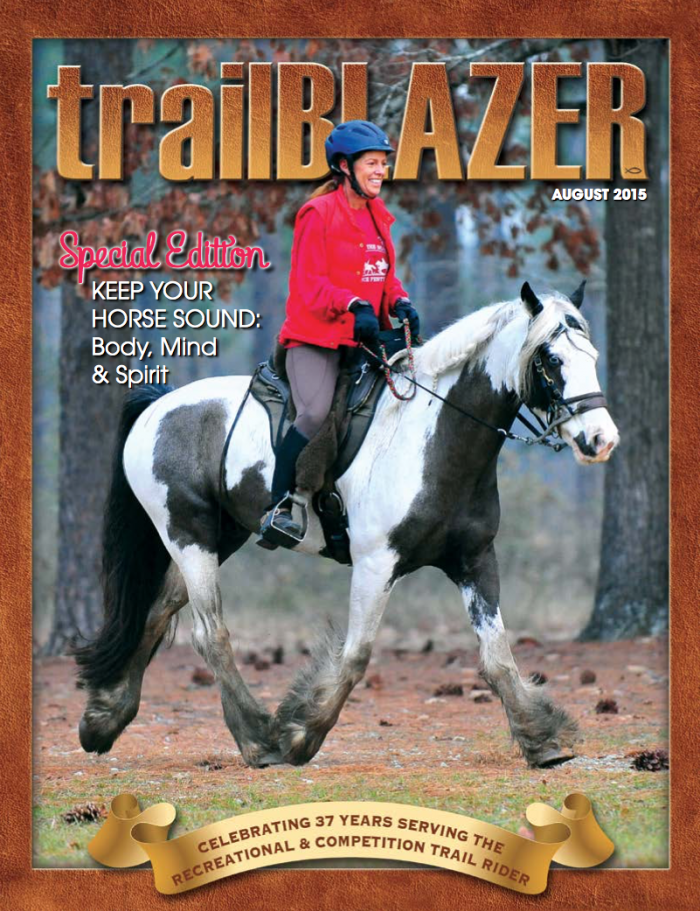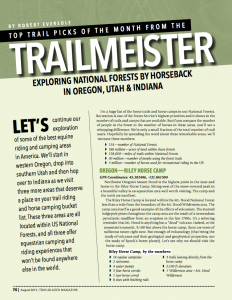 Top Trail Picks by the Numbers
Top Trail Picks by the Numbers
As Published in the August, 2015 issue of Trail Blazer Magazine
This month let’s continue our exploration of some of the excellent equine riding and camping areas in America. We’ll start in western Oregon, drop into southern Utah, and then hop over to Indiana as we visit three more areas that deserve a place on your trail riding and horse camping bucket list. These three areas are all located within U.S. National Forests and all three offer equestrian camping and riding experiences that won’t be found anywhere else in the world.
National Forest Numbers
- 154 – number of National Forests
- 188 milion – acres of land within those forests
- 158,000 – miles of trails within National Forests
- 50 million – number of people using the forest trails
- 3 million – number of horses used for recreational riding in the U.S.
I’m a huge fan of the horse trails and horse camps in our National Forests. Recreation is one of the Forest Services highest priorities and it shows in the number of trails and camps that are available. But if you compare the number of people in the forest to the number of horses in these areas you’ll see a whopping difference. We’re only a small fraction of the total number of trail users. Hopefully by spreading the word about these remarkable areas we’ll increase those numbers.
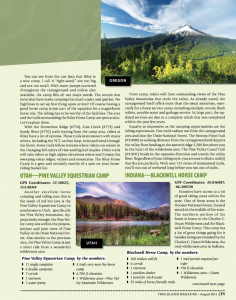 Oregon – Riley Horse Camp
Oregon – Riley Horse Camp
Trailhead Coordinates: 45.382486, -121.861500
LEARN MORE ABOUT THE RILEY HORSE CAMP
Northwest Oregon’s Mount Hood is the highest point in the state and home to the Riley Horse Camp. Sitting west of the snow-covered peak in a beautiful valley is an equestrian area well worth visiting. The camp and the trails are excellent.
The Riley Horse Camp is located within the Mt Hood National Forest less than a mile from the boundary of the Mt Hood Wilderness area. The camp area itself is a good example of the effects of volcanism. The stunted lodgepole pines throughout the camp area are the result of a tremendous pyroclastic mudflow from an eruption in the late 1700’s. It’s a sobering reminder that Mt Hood is anything but a “dead” volcano. Indeed, at the mountain’s summit, 9,140 feet above the horse camp there are vents of sulfurous steam right now. But enough of volcanology (That being the study of volcano’s and their geological, and geophysical properties, not the study of Spock’s home planet.) Let’s see why we should visit the horse camp.
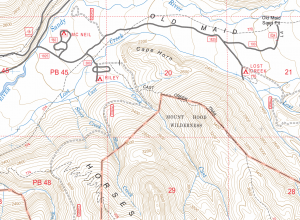
Trails from Riley Horse Camp
Riley Horse Camp by the Numbers:
- 14 equine campsites
- 2 restrooms
- 4 water pumps
- 5 four-horse corrals
- 1 two-horse corral
- 8 sites with hitching rails
- 3 trails leaving directly from the horse camp
- 2,100 ft elevation
- 1 Wilderness area – Mt Hood Wilderness
You can see from the raw data that Riley is a nice camp. I call it “right sized” not too big and not too small. With water pumps scattered throughout the campground and toilets also available the camp fills all of our major needs. The corrals that most sites have make camping that much easier and quicker. No highlines to set up first thing upon arrival! Of course having a good horse camp is just part of the equation for a magnificent horse trip. The riding has to be worthy of the facilities. The area and the trails surrounding the Riley Horse Camp are spectacular. Let’s explore them.
With the Horseshoe Ridge (#774), Cast Creek (#773), and Sandy River (#770) trails leaving from the camp area riders at Riley have a lot of options. These trails interconnect with many others, including the PCT, as they loop, twist, and wind through the forest. Some trails follow streams where riders can rejoice in the changing fall colors of vine and big leaf maples. Other trails will take riders to high alpine elevations where you’ll enjoy the sweeping vistas ridges, valleys, and mountains. The Riley Horse Camp is a gem and certainly worthy of a spot in your horse riding bucket list.
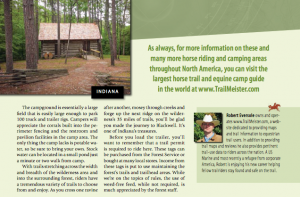 Utah – Pine Valley Equestrian Camp
Utah – Pine Valley Equestrian Camp
Trailhead Coordinates: 37.38025,-113.48314
LEARN MORE ABOUT THE PINE VALLEY EQUESTRIAN CAMP
Another excellent horse camping and riding area that is the result of red hot lava is the Pine Valley Equestrian Camp in south east Utah. In this case the Pine Valley Mountains. Appropriately enough the Pine Valley camp sits within the pinyon, juniper, and pine trees of Pine Valley in the Dixie National Forest. Also similar to the previous area the Pine Valley Camp is just a short ride from a wonderful wilderness area.
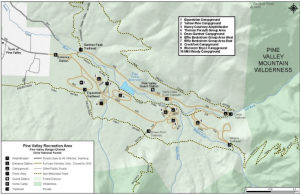
Pine Valley, UT = Excellent horse camping and riding!
Pine Valley Equestrian Camp by the Numbers:
- 11 Single campsites
- 4 Double campsites
- 7 Corrals
- 1 restroom
- 1 water pump
- 5 trails very near the horse camp
- 6,700 ft elevation
- 1 Wilderness area – Pine Valley Mountain Wilderness
From camp riders will have outstanding views of the Pine Valley Mountains that circle the valley. As you’ve already noted the campground itself offers more than the usual amenities especially for a forest service camp, including multiple corrals, flush toilets, potable water and garbage service. In large part the updated services are due to a complete rehab that was recently completed in the past few years.
Equally as impressive as the camping opportunities are the riding experiences. Five trails radiate out from the campground area and into the Dixie National Forest. The Browns Point Trail (#31008) is walking distance from the campground and departs the valley floor heading to the summit ridge 2,500 feet above you in the heart of the wilderness area. The Pine Valley Canal Trail (#31031) heads in the opposite direction and travels the valley floor. Regardless of your riding style you are sure to find a trail(s) that fits you perfectly. With over 151 miles of maintained trails you’ll run out of weekend long before you run out of trails.
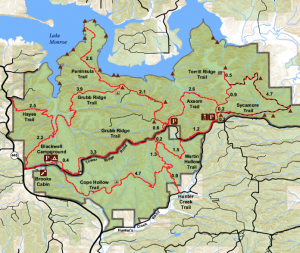
Trails around the Blackwell Horse Camp
Indiana – Blackwell Horse Camp
Trailhead Coordinates: 39.016887, -86.389728
LEARN MORE ABOUT THE BLACKWELL HORSE CAMP
Hoosiers have access to a lot of good riding areas within the state. One of these areas is the Hoosier National Forest located smack in the middle of the state. The northern portion of the forest is home to the Charles C. Deam Wilderness and the Blackwell Horse Camp. This camp has a lot of great things going for it besides being surrounded by the Charles C. Deam Wilderness, the only wilderness area in Indiana.
Blackwell Horsecamp by the Numbers:
- 100 Number of trailers that will fit
- 6 Corrals
- 1 Restroom
- 1 Pavillion shelter
- 1 Pond for stock water
- 35 miles of horse friendly trails
- 1 Trail Permit required per rider
- 750 ft elevation
- 1 Wilderness area – Deam Wilderness
The campground is essentially a large field that is easily large enough park 100 truck and trailer rigs. Campers will appreciate the corrals built into the perimeter fencing and the restroom and pavilion facilities in the camp area. The only thing that the camp lacks is potable water so be sure to bring your own. Stock water can be located in a small pond just a minute or two walk from camp.
With trails stretching across the width and breadth of the wilderness area and into the surrounding forest riders have a tremendous variety of trails to choose from and experiences to enjoy. As you cross one ravine after another, mosey through creeks, and forge up the next ridge on the wilderness’s 35 miles of trails you’ll be glad you made the journey to Blackwell. It’s one of Indiana’s treasures.
Before you load the trailer you’ll want to remember that a trail permit is required to ride here. These tags can be purchased from the Forest or bought at many local stores. Income from these tags is put to use maintaining the forest’s trails and trailhead areas. While we’re on the topics of rules; the use of weed free feed, while not required, is much appreciated by the forest staff.
As always for more information on these and many more horse riding and camping areas throughout North America you can visit the largest horse trail and equine camp guide in the world; www.trailmeister.com.


